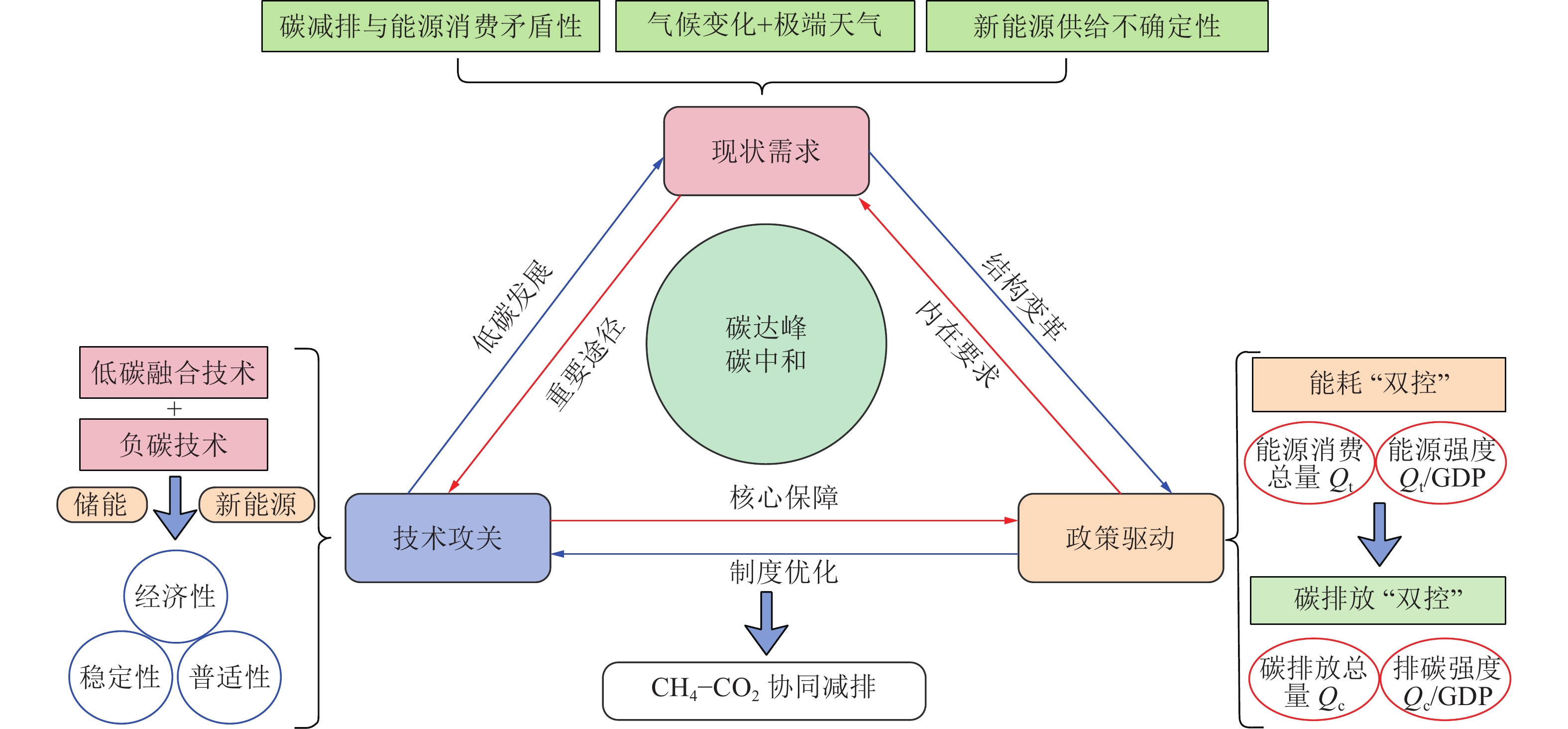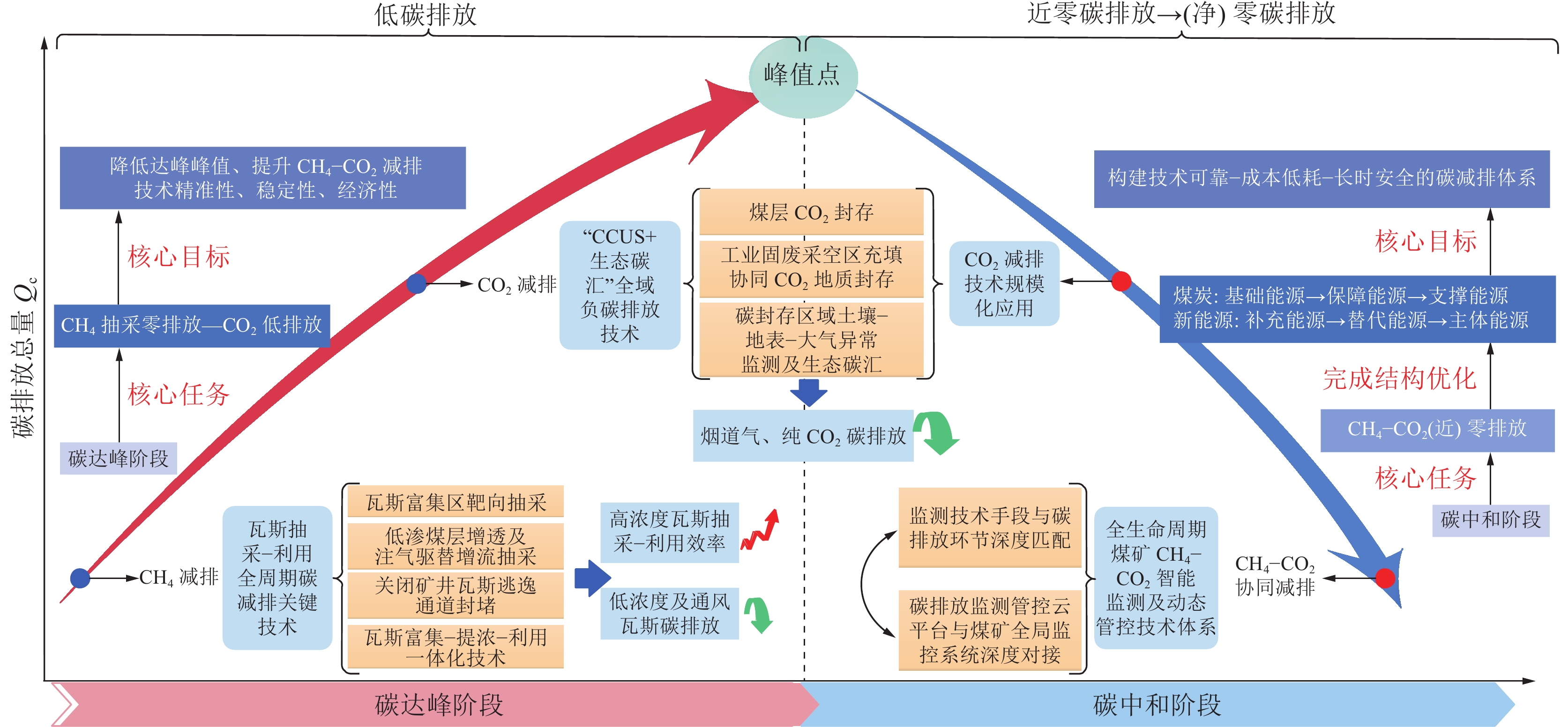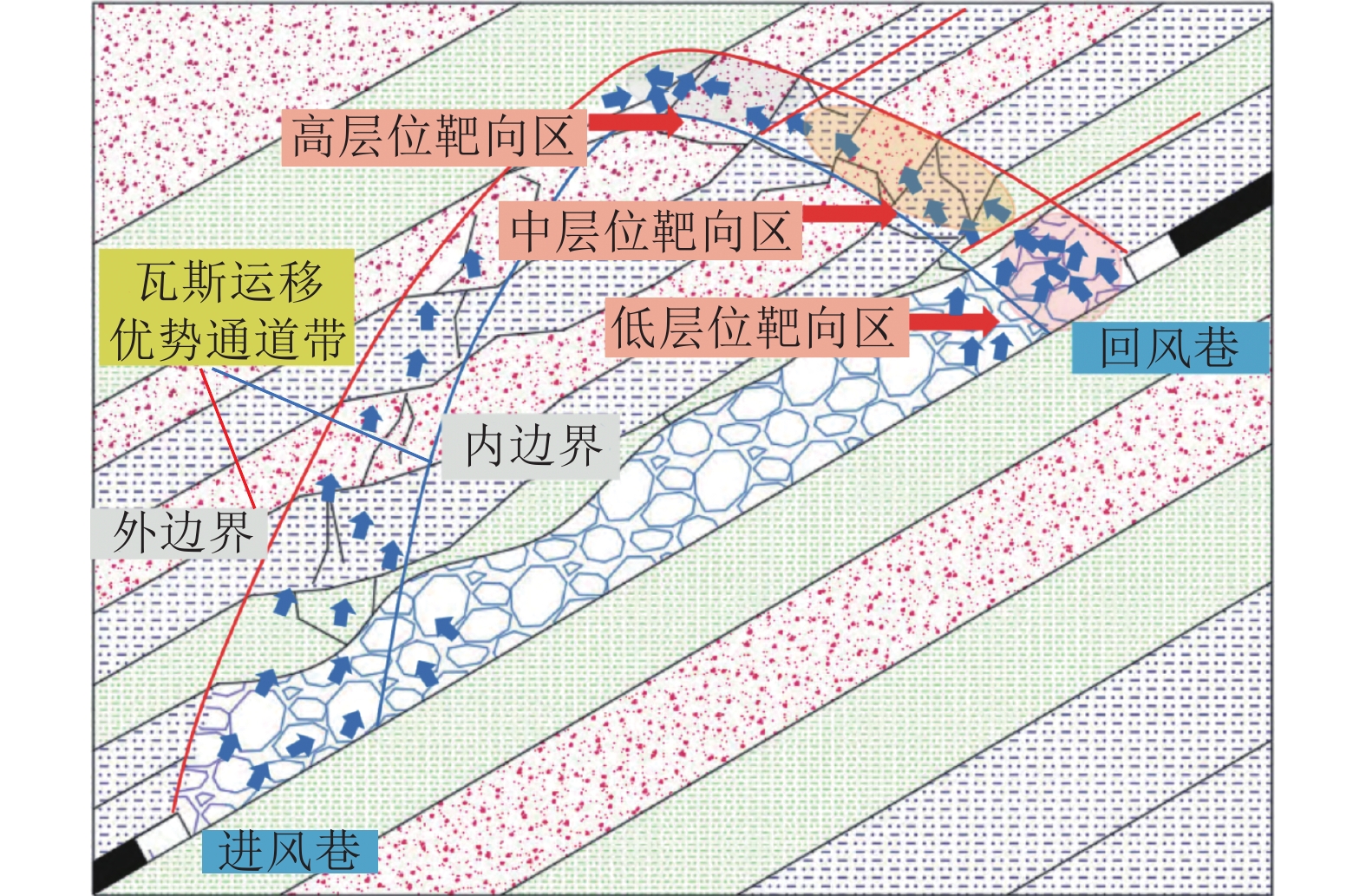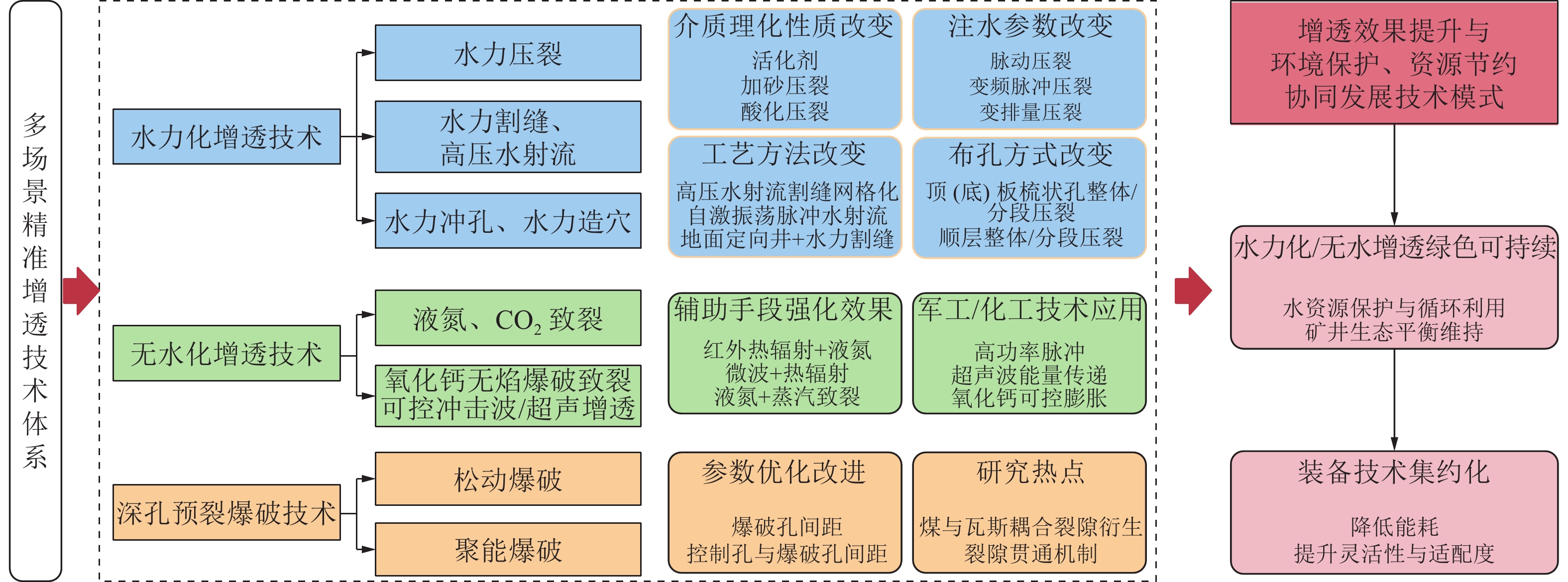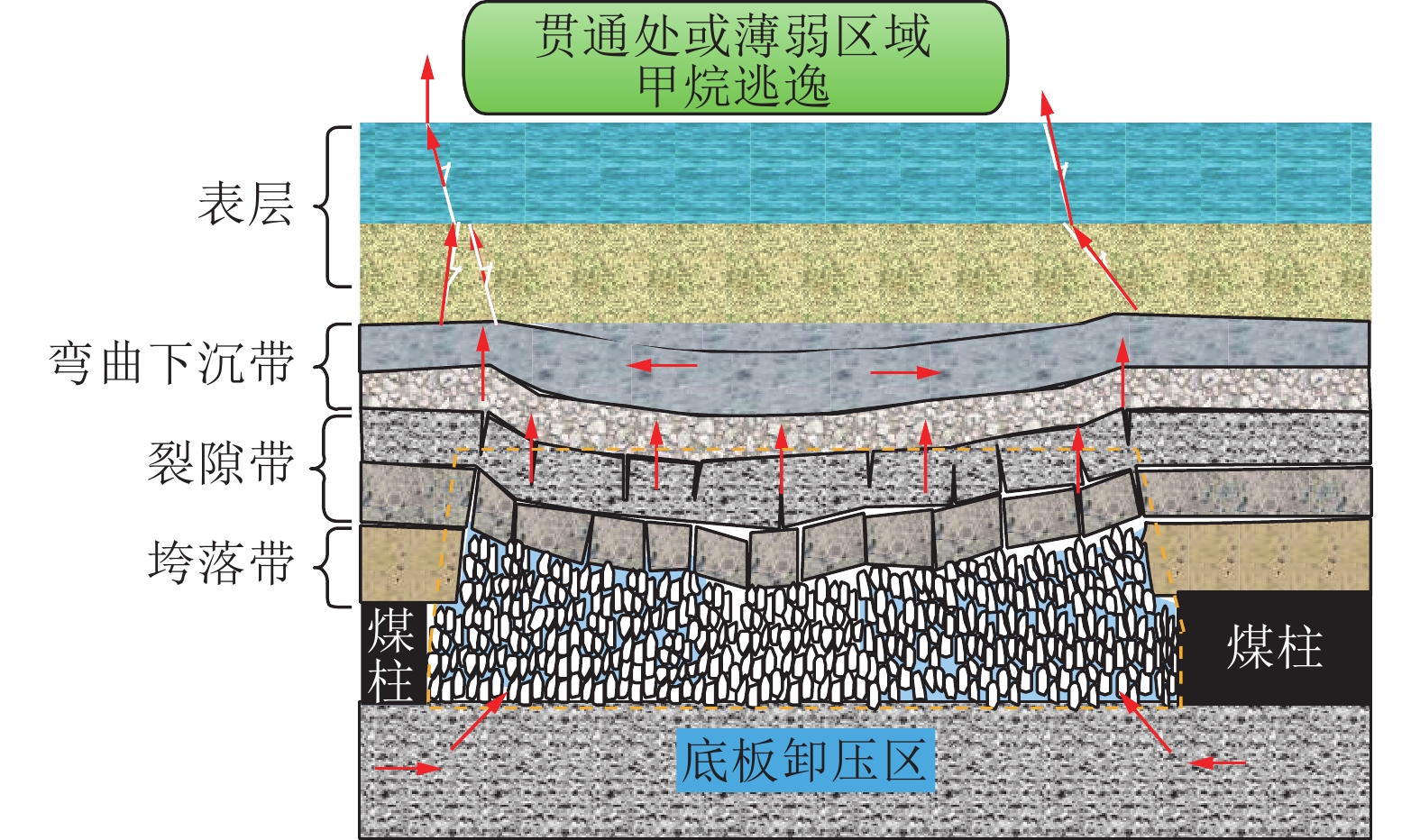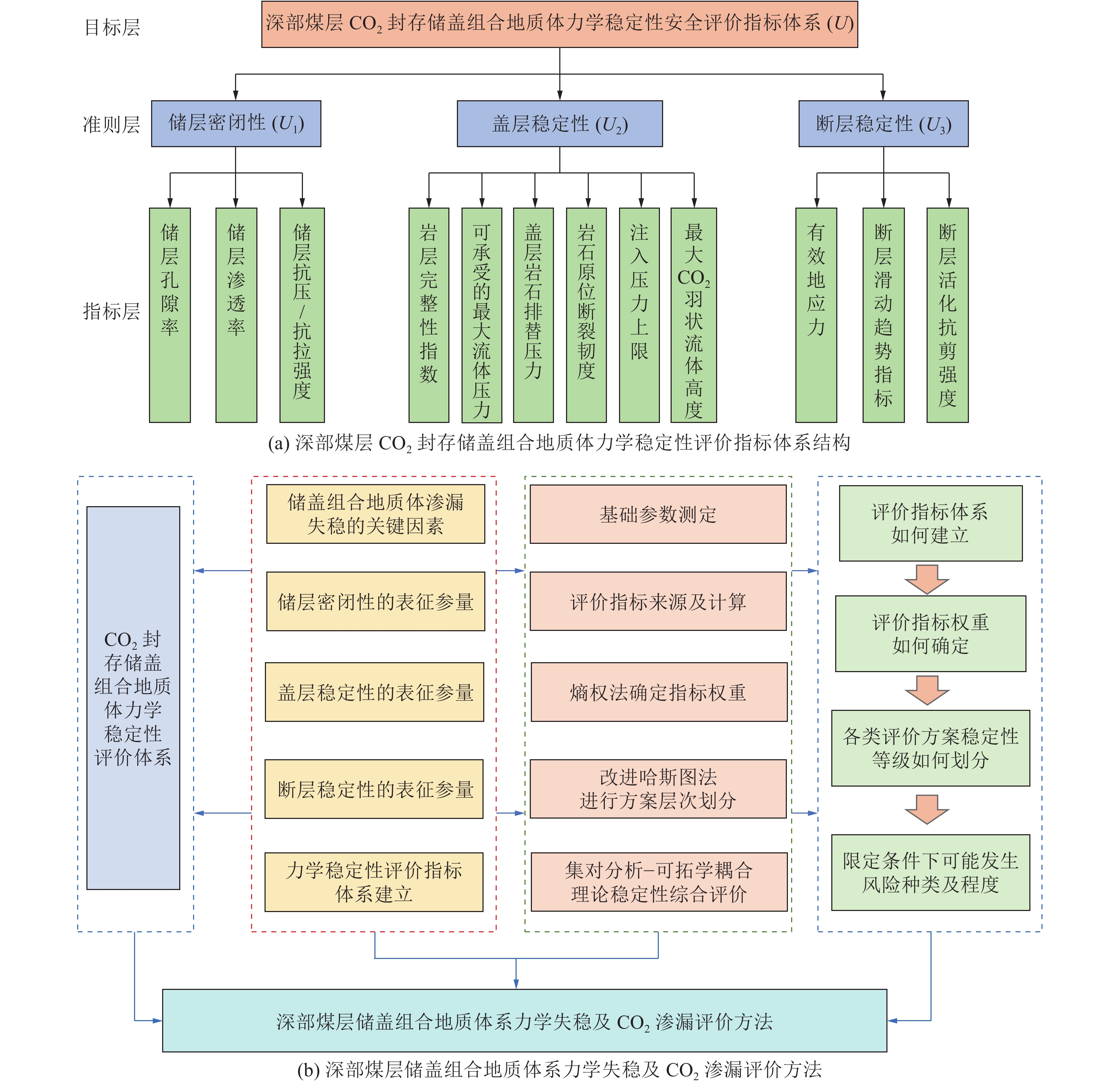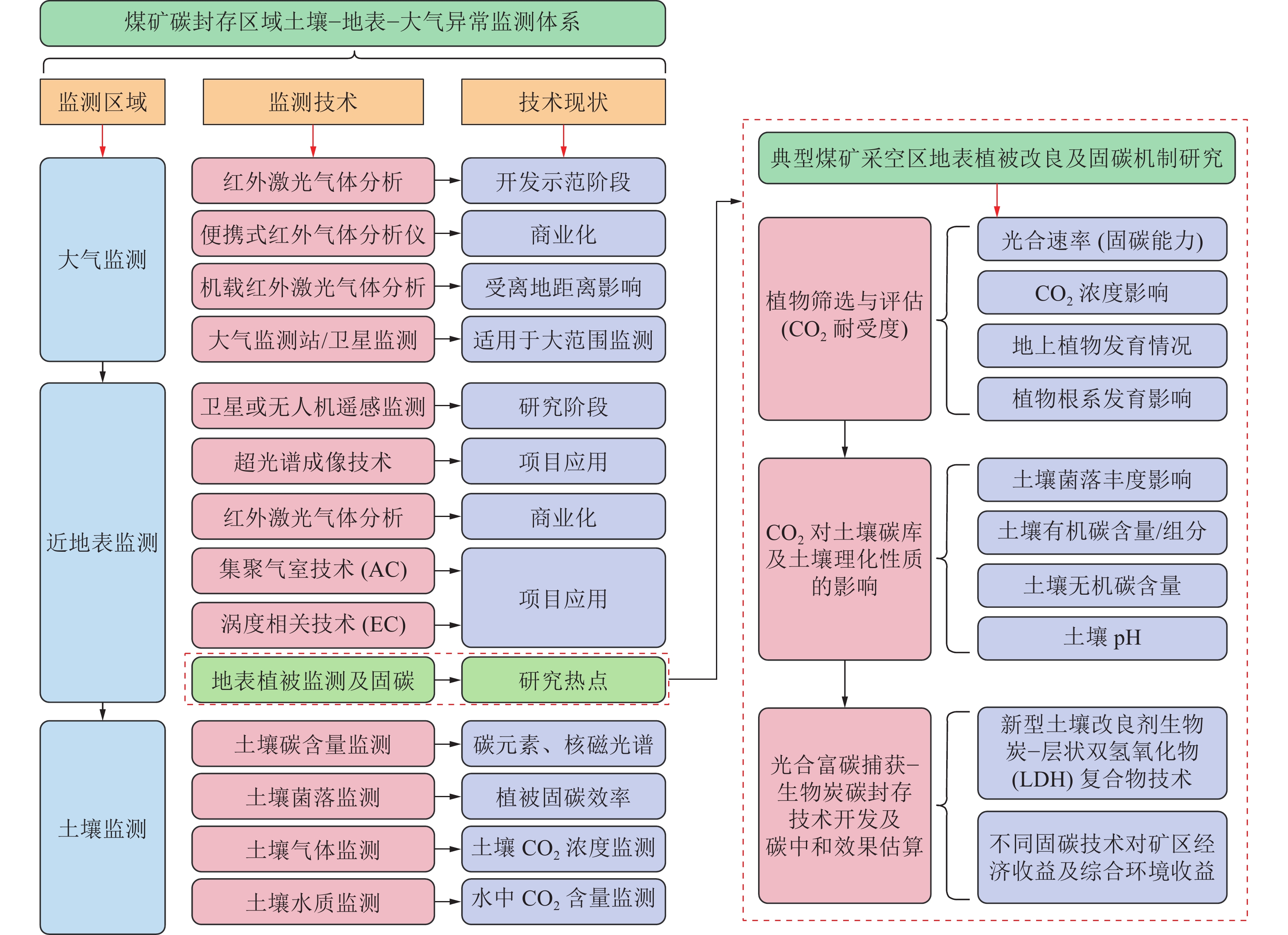Thoughts on the development path of coal and gas co-mining technology in dual carbon strategy
-
摘要:
自提出“双碳”目标以来,我国生态文明建设已进入以降碳为重点战略方向的关键时期。煤炭作为兜底能源的地位短期内不会改变,能耗“双控”向碳排放总量和强度“双控”转变的核心即为CH4−CO2协同减排。在精准分析碳达峰、碳中和阶段煤矿CH4−CO2双重碳减排面临挑战的基础上,明确了双碳战略中煤气共采技术发展需结合现状需求−技术攻关−政策驱动的核心原则,制定了双碳战略中煤气共采技术的发展路径,论述了其中的关键技术问题。碳达峰阶段,CH4减排以排放源管控为基础视角,核心为瓦斯抽采−利用全周期碳减排关键技术,包含瓦斯富集区靶向精准抽采技术、低渗煤层增透及注气驱替增流抽采技术、关闭矿井瓦斯逃逸通道封堵减碳技术、瓦斯富集−提浓−利用一体化技术,目的是大幅提升高浓度瓦斯抽采−利用效率,减少低浓度及通风瓦斯碳排放;CO2减排以“CCUS+生态碳汇”全域负碳排放技术为核心,包含煤层CO2封存、工业固废采空区充填协同CO2地质封存、煤矿碳封存区域土壤−地表−大气异常监测及生态碳汇技术,进一步吸纳烟道气或纯CO2排放。碳中和阶段核心任务是实现CH4−CO2(近)零碳排放,CO2减排应当由技术攻关示范工程转变为规模化应用阶段,并建立全生命周期煤矿CH4−CO2排放智能监测及动态管控技术体系,实现监测管控技术手段与碳排放环节深度匹配、碳排放监测管控云平台与煤矿全局监控系统深度对接。最后对未来煤气共采体系绿色低碳发展提出了自身见解与思考:①继续深化“高效精准抽采+全浓度梯级利用”煤矿CH4零排放技术模式;②持续攻关“CO2工程封存+生态碳汇”CO2零排放技术体系;③积极探索煤矿“零碳智慧园区”综合解决方案,形成激励和倒逼并重的煤矿碳减排政策支持体系。
-
关键词:
- 双碳目标 /
- CH4−CO2协同减排 /
- 煤气共采 /
- 发展路径 /
- 绿色低碳
Abstract:The construction of China’s ecological civilization has entered a critical period in which carbon reduction is the key strategic direction since the “dual carbon” goal was proposed. Coal’s status as the least expensive energy source will be unchanged in the short term. CH4-CO2 coordinated emission reduction is the core of the convert from “dual control” of energy consumption to “dual control” of total carbon emissions and intensity. On the basis of accurately analyzing the challenges of CH4-CO2 dual carbon emission reduction in coal mines at the stage of carbon peak and carbon neutrality, the development of coal and gas co-mining technology in the dual carbon strategy has been clarified to be combined with the core principles of current demand-technical research-policy drive, the development path of coal and gas co-mining technology in the dual carbon strategy is formulated, and the key technical issues are discussed. At the peak stage of carbon emission, CH4 emission reduction is based on the perspective of emission source control. The core is the key technology for carbon emission reduction in the whole cycle of gas extraction and utilization, including the targeted and accurate extraction technology in gas-rich areas, the permeability-enhancement, replacement and flow-increasement extraction by injecting gas in low-permeability coal seams, the gas escape channel plugging and carbon reduction technology in closed mines, and the integrated technology of gas enrichment-concentration-utilization. The purpose is to greatly improve the efficiency of high-concentration gas extraction and utilization and to reduce the carbon emission from low-concentration and ventilated gas. CO2 emission reduction is centered on the “CCUS + ecological carbon sink” region-wide negative carbon emission technology to further absorb flue gas and pure CO2 emissions, including CO2 storage in coal seams, industrial solid waste goaf filling synergistic CO2 geological storage, soil-surface-atmosphere anomaly monitoring and ecological carbon sink technology in coal mine carbon storage areas, etc. The core task of the carbon neutralization stage is to achieve CH4-CO2 (near) zero carbon emission. CO2 emission reduction should be transformed from a technical research demonstration project to a large-scale application stage, and establishing an intelligent monitoring and dynamic control technology system for CH4-CO2 emission from coal mine in the whole life cycle to realize the in-deep matching between monitoring and control technology means and carbon emission links, and the in-deep docking between the monitoring-control cloud platform of carbon emission and the global monitoring-control system of coal mines. Finally, the insights and thoughts is put forward on the green and low-carbon development of the future coal and gas co-mining system. ① Continue to deepen the coal mine CH4 zero emission technology model of “efficient and accurate extraction + full-concentration cascade utilization”. ② Continue to tackle the CO2 zero emission technology system of “CO2 engineering storage + ecological carbon sinks”. ③ Actively exploring the comprehensive solution of “zero carbon wisdom park” in coal mines, and forming a policy support system for carbon emission reduction in coal mines that emphasizes both incentive and pushback.
-
0. 引 言
煤炭作为基础能源,在我国能源结构中长期占据着主导地位。但随着煤炭开采程度的深入,煤矿井田工作面回采造成地层原生裂隙扩大或产生新的开采裂隙导致的导水裂隙带发育高度沟通上覆具有一定富水程度的充水含水层,从而发生煤层顶板涌(突)水事故,威胁矿井安全生产[1-3]。煤层顶板含水层富水性的分区与评价研究是评估煤层顶板水害发生风险的重要方面,若导水裂隙带导通的含水层富水性强,则易发生顶板水害事故;反之,如果导水裂隙带发育,沟通的含水层区域富水性较弱,不易发生危害矿井安全的涌(突)水事件[4-6]。因此查清煤层顶板充水含水层的富水性对指导煤矿井田的安全生产具有重要意义,是提出合理有效的井田防治水措施的基础[7-8]。
《煤矿防治水细则》(原《煤矿防治水规定》)中仅以钻孔口径91 mm、抽水水位降深10 m的单位涌水量评价含水层的富水性[9]。2011年,中国矿业大学(北京)武强院士等提出了富水性指数法,建立了系统完整的基于GIS的信息融合型含水层富水性分布规律评价模型,综合反映受多个指标影响的含水层富水性的相对强弱[10-12],而后该法在我国各个矿区得到广泛应用,张云峰等[13]、刘景等[14]、黄欢等[15]分别应用该法分析研究新疆木垒县某矿、大南湖7号煤矿、塔然高勒煤矿的顶板含水层富水性。孙福勋[16]基于Fisher判别分析法预测含水层富水性。陈康等[17]采用瞬变电磁结合抽水试验成果,用单位涌水量定量估计整个测区含水层富水性;石守桥等[18]运用最直接的岩性结构和断层构造分析评价顶板含水层富水性。张姝等[19]基于改进的灰色可拓关联法评价顶板砂岩含水层富水性。吕玉广等[20]提出了适用于各种地质条件的技术评价体系“多类型四双法”(MTFD)评价煤层顶板突水情况。梁向阳等[2]通过物探和钻探工程成果分析,进行矿井首采区工作面的富水性分区与评价。这些方法有效评价了煤层顶板含水层的富水性,为矿井的安全生产提供了指导。
核桃峪井田首采区由于煤层开采而产生的导水裂隙带大部分延伸至顶板洛河组含水层,使其成为直接充水含水层,对煤矿的充水产生不同程度的影响。为查明研究区直接充水含水层的富水性,笔者以核桃峪井田首采区煤8上覆洛河组砂岩含水层为研究对象,分别基于AHP-CRITIC法和FDAHP-独立权系数法复合影响下的组合赋权法赋予评价指标权重,利用富水性指数法耦合各主控因素及其权重,建立主客观权重综合影响下的核桃峪首采区煤8层顶板洛河组含水层富水性指数模型,结合物探成果对比验证,增强富水性评价结果的可靠性,为提出合理的煤矿井田防治水措施提供依据。
1. 研究区概况
宁正矿区核桃峪井田位于正宁县西南部,矿井设计能力为8.0 Mt/a,服务年限109.8 a。研究区为核桃峪井田首采区(图1),可划分为一盘区和二盘区2个盘区,位于核桃峪井田西南部,勘探程度高,水文地质条件较清楚,交通便利且运输方便。
研究区主要发育的地层自上而下分别是第四系、白垩系、侏罗系和三叠系。第四系主要是大范围分布的黄土,构成黄土塬、梁、峁地貌,平均厚度约187 m。白垩系志丹群包括宜君组、洛河组和环河华池组,环河组主要为细砂岩,发育水平层理及虫孔构造,下部含石膏,平均厚度约200 m;洛河组粗砂岩全井田分布,胶结较差,岩性疏松均一,斜层理发育,平均厚度约413 m;宜君组以砂砾岩为主,较致密。侏罗系地层以粉砂岩为主,平均厚度约117 m,其中侏罗系延安组为主要含煤地层,也是本次研究目的层煤8层所在地层。三叠系上统延长群为粉砂岩地层,含煤线,发育水平互层层理。研究区综合柱状图如图2所示。
井田顶板含水层划分为第四系全新统砂砾层孔隙潜水含水层、下白垩统志丹群碎屑岩类孔隙裂隙潜水含水层、下白垩统志丹群孔隙裂隙承压含水层和中侏罗统直罗组、延安组上中部(煤8层顶板以上)砂岩复合承压含水层等四大主要含水层。研究区主要可采煤层为延安组煤8层,平均厚度12.74 m,分布稳定,全区可采。随着开采程度加深,煤层开采形成的导水裂隙带沟通洛河组含水层,因此主要充水含水层为煤层上覆富水性强的洛河组巨厚层砂岩裂隙含水层,矿床水文地质条件复杂。
2. 煤层顶板洛河组含水层富水性评价主控因素分析
煤层顶板洛河组含水层富水性并不是受单一指标控制的,通过收集和分析矿区井田的勘探成果、地质条件及水文地质特征等资料,确定了含水层厚度、岩心采取率、脆塑性岩厚度比、冲洗液消耗量、渗透系数、单位涌水量等6个影响核桃峪井田首采区煤层顶板含水层富水性的主要控制因素。
2.1 含水层厚度
研究区内洛河组地层以砂岩为主,含水层厚度为335~470 m,平均厚度380 m,根据核桃峪井田钻孔揭露的地层厚度绘制洛河组含水层厚度等值线图如图3a所示。由图3a可知,研究区内含水层厚度整体呈现出自北向南逐渐由厚变薄的趋势,西部局部区域存在厚度低值区,厚度在平均厚度以下。
2.2 岩心采取率
岩心采取率是反映岩土体的硬度和破碎程度的指标,根据钻孔数据绘制岩心采取率等值线图如图3b所示。研究区内洛河组含水层岩心采取率为36%~93%,平均岩心采取率53%,岩石整体破碎程度较低,西部的钻孔ZJ4、ZJ5岩心采取率约40%和东北部的钻孔K32、K44、K52等钻孔岩心采取率最低可达36%,采取率较低,岩石相比较破碎。
2.3 脆塑性岩厚度比
脆塑性岩厚度比是指脆性岩(砂岩、砾岩)厚度和塑性岩(泥岩、砂质泥岩)厚度的比值,简称脆塑比,根据钻孔资料绘制脆塑比专题图如图3c所示。洛河组含水层脆塑性岩厚度比为6.89~372.2,平均93.74,研究区东南K47钻孔未查见塑性岩石,脆塑比达到最大值372.2。
2.4 冲洗液消耗量
冲洗液消耗量反映含水层裂隙发育程度,其等值线如图3d所示。研究区洛河组含水层冲洗液消耗量为0.3~1.3 m³/h,平均0.36 m³/h,呈现出中西部消耗量大而西部消耗量较小的特征,K24钻孔冲洗液量为1.3 m³/h,消耗量最大。
2.5 渗透系数
该参数反映的是岩体的的透水能力,根据抽水试验成果得到渗透系数,绘制等值线图(图3e)。洛河组含水层渗透系数为0.03~0.91 m/d,据图3e显示,渗透系数表现为由中部区域向四周分散递减的趋势,存在明显边界。
2.6 单位涌水量
将抽水试验成果中的涌水量数据换算为《煤矿防治水细则》规定的孔径为91 mm的单井抽水孔,稳定降深为10 m时的单位涌水量,如图3f所示。由图3f可知,洛河组含水层单位涌水量为0.16~0.27 L/(s·m),研究区洛河组单位涌水量呈现由西向东逐渐减小的趋势。
3. 基于AHP-CRITIC法的含水层富水性分区与评价
3.1 确定主控因素权重
层次分析法(AHP)是把复杂问题中的各指标因素划分为具有关联的有序层次和条理化的多准则决策方法,根据专家经验按照一定规则进行打分,从而获得主控因素的主观权重;CRITIC法主要考虑指标数据之间的波动性和相关关系大小,即通过数据的波动性指标和冲突性指标获取客观权重值,减少指标信息间的重叠。因主客观权重的赋权依据不同,同时考虑专家经验和实际情况下指标数据之间的内在关系获得的指标权重更加科学合理,能够得到更加准确的顶板含水层富水性分区情况。笔者采用基于AHP和CRITIC法的组合赋权法获取主控因素的综合权重,一般步骤如下。
3.1.1 层次分析法计算主观权重
1)建立层次结构分析模型。以核桃峪井田首采区煤层顶板洛河组含水层富水性为本文研究的目的层(A层),准则层(B层)为含水层、岩性特征和水力特征,以含水层厚度、岩心采取率、脆塑性岩厚度比、冲洗液消耗量、渗透系数以及单位涌水量等6个具体的地学信息为分析模型的指标层(C层),建立研究每层顶板洛河组含水层富水性的层次结构分析模型如图4所示。
2)构造判断矩阵计算主观权重。分析各评价指标对洛河组含水层富水性的重要性,以T.L.Saaty创建的1~9标度法为依据,并结合专家意见,对主控因素进行相对重要性评分,构造煤层顶板含水层富水性评价的判断矩阵,计算得各层次单排序的权重值W,见表1—表4。
表 1 判断矩阵A~Bi(i=1, 2, 3)Table 1. Judgment matrix A~Bi(i=1, 2, 3)A $ {B}_{1} $ $ {B}_{2} $ $ {B}_{3} $ W(A·B−1) $ {B}_{1} $ 1 1/2 1/2 0.1634 $ {B}_{2} $ 2 1 1/2 0.2970 $ {B}_{2} $ 2 2 1 0.5396 注:最大特征值λmax=3.009 2,一致性CR=0.008 8,CI=0.004 6。 表 2 判断矩阵B1~Ci(i=1)Table 2. Judgment matrix B1~Ci(i=1)B1 C1 C1 W(B1·Ci−1) C1 1 1 0.500 0 C1 1 1 0.500 0 注:最大特征值λmax=1,一致性CR=0,CI=0。 表 3 判断矩阵B2~Ci(i=2,3)Table 3. Judgment matrix B2~Ci(i=2,3)B2 C2 C3 W(B2·Ci−1) C2 1 2 0.666 7 C3 1/2 1 0.333 3 注:最大特征值λmax=2,一致性CR=0,CI=0。 表 4 判断矩阵B3~Ci(i=4,5,6)Table 4. Judgment matrix B3~Ci(i=4,5,6)B3 C4 C5 C6 $W\left( {{B}_{3}}\cdot C_{i}^{-1} \right) $ C4 1 1/2 1/2 0.1958 C5 2 1 1/2 0.3108 C6 2 2 1 0.493 4 注:最大特征值λmax= 3.05362 ,一致性CR=0.05156 ,CI=0.026 81。由表1—表4可得各组判断矩阵的最大特征值λmax,一致性指标CR和CI,且各矩阵的CR均小于0.1,可知其一致性较好,通过一致性检验。因此,确定各主控因素的主观权重计算值(表5)。
表 5 各主控因素主观权重Table 5. Subjective weight of main controlling factor主控因素 C1 C2 C3 C4 C5 C6 权重 0.163 4 0.198 0 0.099 0 0.105 7 0.1677 0.266 2 3.1.2 CRITIC法计算客观权重
CRITIC法计算权重需要对指标进行数据标准化处理,通过GIS的提取至点功能将各指标数据值提取到相同点位后运用极值法进行指标归一化,消除量纲。数据标准化后计算主控因素的冲突性指标和波动性指标见表6,基于这两大指标计算得到各主控因素的客观权重值见表7。
表 6 各主控因素指标值Table 6. Index value of main controlling factor主控因素 C1 C2 C3 C4 C5 C6 波动性指标 0.209 0.230 0.171 0.268 0.215 0.244 冲突性指标 5.410 4.940 6.241 4.482 4.395 4.347 信息承载量 1.132 1.137 1.068 1.201 0.947 1.060 表 7 各主控因素客观权重Table 7. Objective weight of main controlling factor主控因素 C1 C2 C3 C4 C5 C6 权重 0.173 0 0.173 8 0.163 2 0.183 5 0.144 6 0.161 9 3.1.3 组合赋权法确定综合权重
运用组合赋权法将主客观权重值有机结合,既考虑主控因素的客观性,又降低了评价结果的主观性,计算公式如式(1)所示,综合权重计算值见表7。
$$ {W}_{i}=\frac{{S}_{i} {O}_{i}}{\displaystyle\sum _{i=1}^{n}{S}_{i} {O}_{i}} $$ (1) 式中:n为主控因素的个数;Si为第i个主控因素主观权重;Oi为第i个主控因素客观权重;Wi为第i个主控因素综合权重。各主控因素综合权重见表8。
表 8 各主控因素综合权重Table 8. Combined weight of main controlling factor主控因素 C1 C2 C3 C4 C5 C6 权重 0.170 7 0.207 8 0.097 6 0.117 1 0.146 5 0.260 3 3.2 富水性分区与评价
引入富水性指数法评价煤层顶板含水层富水性的原理如式(2)所示。
$$ WI=\sum _{k=1}^{n}{W}_{i}\cdot {f}_{i}\left(x\text{,}y\right) $$ (2) 式中:$ WI $为富水性指数;$ \left(x,y\right) $为因素地理坐标;$ {f}_{i}\left(x,y\right) $为单因素的影响值函数。
将组合赋权法计算的主控因素的综合权重代入式(2),得到评价核桃峪井田首采区煤层顶板洛河组含水层富水性的模型如下:
$$ \begin{gathered} {WI}=0.170\;7{f}_{1}\left(x,y\right)+0.2078{f}_{2}\left(x,y\right)+\\{0.097\;6f}_{3}\left(x,y\right)+0.1171{f}_{4}\left(x,y\right)+\\0.146\;5{f}_{5}\left(x,y\right)+{0.2603f}_{6}\left(x,y\right) \end{gathered} $$ (3) 基于上述富水性指数模型,应用GIS软件的空间分析功能将归一化后的主控因素复合叠加,得到富水性指数为0.241~0.738,数值越大,富水性越强。以0.377、0.438、0.511、0.569为分区阈值将研究区划分为弱富水区、较弱富水区、中等富水区、较强富水区、强富水区等5个不同富水区,得到顶板含水层富水性分区图(图5)。由图5可知,研究区洛河组含水层富水性分布不均,与各个主控因素的分布情况有明显差异,弱富水区、较弱富水区分布在研究区东部,较强富水区和强富水区集中在研究区西部,较强富水区分布面积大,中部和西部局部地区存在强富水区,是煤层开采的重点关注对象,需提前进行探放水工作。
4. 基于FDAHP-独立权系数法的含水层富水性分区与评价
4.1 主控因素权重确定
模糊德尔菲层次分析法(FDAHP)是一种能够让决策者充分参与权重确定和分析的决策方法,基本思想是将各个专家给出的确定型两两判断距阵用模糊三角数的形式加以合成,形成一个群体模糊两两判断距阵后依据模糊三角数的性质以及一定的运算方法,确定出该群体模糊判断矩阵的模糊权重向量,处理后形成一个交互式的权重向量决策分析过程,最终确定出决策者满意的群体决策权重向量。独立性权系数法是一种确定客观权重的方法,基本原理是根据数理统计学中的多元回归分析计算出复相关系数从而得到权重,适用于各评价指标存在错综复杂关系、需要排除各评价指标之间重复信息的研究。为更全面地考虑指标重要性,引入拉格朗日乘数法融合主客观权重,获取更加真实的权重值,据此有效评价煤层顶板含水层富水性。分析研究区数据资料,排除重复信息,选取含水层厚度C1,岩心采取率C2,脆塑性岩厚度比C3,洛河组钻孔冲洗液消耗量C4等4个影响煤层顶板洛河组含水层富水性的主控因素。采用FDAHP-独立权系数法的主控因素权重确定过程如下。
4.1.1 基于模糊德尔菲层次分析法的主观权重
通过专家调查法(传统德尔菲法),征集各领域专家及科研工作者的意见,按照1—9级标度法,对每个主观因素的影响高低进行相对重要性评价,见表9,并根据式(4)建立两两比较判断矩阵。
表 9 各主控因素对煤层顶板富水性重要性Fi评价值Table 9. The value of the importance rating of main controlling factor on the water abudance of coal seam roof专家编号 F1 F2 F3 F4 P1 2 3 6 6 P2 3 5 6 6 P3 1 2 6 6 P4 2 4 5 5 $$ \boldsymbol{M}_{\mathrm{p}}=\left[\begin{array}{cc}\begin{array}{cc}1& {a}_{12}\\ 1/{a}_{12}& 1\end{array}& \begin{array}{cc}{a}_{13}& {a}_{14}\\ {a}_{23}& {a}_{24}\end{array}\\ \begin{array}{cc}1/{a}_{13}& 1/{a}_{23}\\ 1/{a}_{14}& 1/{a}_{24}\end{array}& \begin{array}{cc}1& {a}_{34}\\ 1/{a}_{34}& 1\end{array}\end{array}\right] $$ (4) 其中,$ {a}_{ij} $=Fi/Fj为主控因素Ci和Cj的相对重要程度的判断,Fi、Fj分别为某一专家对主控因素Ci和Cj的赋值。根据4位专家对4项主控因素的评估结果,建立4个4×4的两两比较判断矩阵式MP1—MP4。
$$ {\boldsymbol{M}}_{P 1}=\left[\begin{array}{cccc}1 & 0.667 & 0.333 & 0.333 \\ 1.5 & 1 & 0.8 & 0.8 \\ 3 & 1.25 & 1 & 1 \\ 3 & 1.25 & 1 & 1\end{array}\right] $$ $${\boldsymbol{ M}}_{P 2}=\left[\begin{array}{cccc}1 & 0.6 & 0.5 & 0.5 \\ 1.677 & 1 & 0.5 & 0.5 \\ 2 & 2 & 1 & 1 \\ 2 & 2 & 1 & 1\end{array}\right] $$ $$ {\boldsymbol{M}}_{P 3}=\left[\begin{array}{cccc}1 & 0.5 & 0.167 & 0.167 \\ 2 & 1 & 0.833 & 0.833 \\ 6 & 1.2 & 1 & 0.8 \\ 6 & 1.2 & 1.25 & 1\end{array}\right] $$ $$ {\boldsymbol{M}}_{P 4}=\left[\begin{array}{cccc}1 & 0.5 & 0.4 & 0.4 \\ 2 & 1 & 0.333 & 0.333 \\ 2.5 & 3 & 1 & 1 \\ 2.5 & 3 & 1 & 1\end{array}\right] $$ FDAHP主要解决层次分析法不能克服的不确定性和模糊性问题,引入模糊判断矩阵(模糊三角数)消除决策者决策时的模糊性,而后利用几何平均分和归一化法由式(5)获得各评价指标的最终决策权重,即4个主控因素对洛河组含水层富水性影响的权重值见表10。
表 10 FDAHP法计算指标权重结果Table 10. Index weight results calculated by FDAHP method主控因素 含水层
厚度C1岩心采
取率C2脆塑性岩
厚度比C3冲洗液消
耗量C4权重 0.1124 0.3371 0.3371 0.2133 $$ {W}_{i}=\frac{{\left({w}_{i}^{L}{w}_{i}^{M}{w}_{i}^{U}\right)}^{\textstyle\frac{1}{3}}}{\displaystyle\sum _{i=1}^n{\left({w}_{i}^{L}{w}_{i}^{M}{w}_{i}^{U}\right)}^{\textstyle\frac{1}{3}}} \text{,}i=(1\text{,}2\text{,}…\text{,}n) $$ (5) 4.1.2 独立性权系数法计算权重
独立性权重法利用多元回归方法,通过计算复相关系数R进行定权。第一,复相关系数R越大说明重复信息越多,权重则越小;第二,复相关系数倒数1/R值越大,则说明权重应该越大;第三,最终权重由复相关系数倒数1/R值进行归一化得到,见表11。
表 11 独立性权重法计算权重结果Table 11. Summary of weight calculation results by independence weight method主控因素C 复相关系数R 复相关系数倒数1/R 权重 C1 0.281 3.555 0.235 6 C2 0.243 4.113 0.272 6 C3 0.357 2.800 0.185 6 C4 0.216 4.620 0.306 2 为更加全面地考虑指标重要度,引入拉格朗日乘数法对主观赋权$ {S}_{i} $和客观赋权$ {O}_{i} $进行融合,获得更加真实的权重值,根据式(6)得到各指标的组合权重$ {W}_{i} $=($ {W}_{1} $, $ {W}_{2} $,···, $ {W}_{n} $), 见表12。
表 12 拉格朗日乘数法计算综合权重结果Table 12. Comprehensive weight calculated by Lagrange multiplier method主控因素 含水层
厚度C1岩心采
取率C2脆塑性岩
厚度比C3冲洗液消
耗量C4权重 0.167 5 0.312 0 0.257 5 0.263 0 $$ {W}_{i} = \frac{\sqrt{S_iO_i}}{\displaystyle\sum _{i=1}^{n}\sqrt{S_iO_i}} $$ (6) 式中:$ {S}_{i} $为FDAHP计算的第i个主控因素的主观权重;$ {O}_{i} $为独立权系数法计算的第i个主控因素的客观权重。
4.2 富水性分区与评价
将拉格朗日乘数法计算的主控因素的综合权重与富水性指数模型相结合,得到评价核桃峪井田首采区煤层顶板洛河组含水层富水性的评价模型如下:
$$ \begin{split} WI=&0.167\;5{f}_{1}\left(x,y\right)+0.263{f}_{2}\left(x,y\right)+\\&{0.257\;5f}_{3}\left(x,y\right)+0.312{f}_{4}\left(x,y\right) \end{split} $$ (7) 基于FDAHP-独立权系数法的研究区富水性指数为0.207~0.606,以0.348、0.399、0.435、0.489为分区界限绘制洛河组含水层富水性分区图,如图6所示。由图6可知,运用该方法得到的洛河组含水层富水性整体具有西北强而东南弱的趋势,强富水区以点状形式分布在整个评价区,主要集中在研究区中部和西部区域;较强富水区大面积连续展布在研究区的西北部;中等富水区主要以不规则条带状分布在研究区的东南;较弱富水区以丘陵状分布在研究区的东部和南部区域,局部区域的较弱富水区点状散落在评价区的西北部和中部;富水性最弱的区域以点状形式分布在研究区东北和南部局部地区。分析可知,研究区煤层顶板洛河组含水层的富水性总体中等较强,研究区的西北区域和东南部的局部区域存在的强富水区和较强富水区需重点关注。
5. 物探成果分析含水层富水性
利用瞬变电磁法进行勘探,查明了核桃峪首采区洛河组含水层的富水异常情况以及洛河组上部、中部和下部的相对富水异常区。首采区和物探范围的位置关系如图7所示。
由图8可知,洛河组砂岩含水层的反演电阻率为25~72 Ω·m;总体来说,测区大部份呈现出相对低阻的特征,图中呈蓝色的区域范围在顺层切片图上表现为低阻封闭圈,呈现出低阻异常特征。从图中可以看出勘探区洛河组砂岩低阻异常区在全区内都有分布。
根据收集勘探区水文资料结合数理统计异常阈值划分,洛河组底部电阻率低于35 Ω·m为相对富水异常区;洛河组中部电阻率低于46 Ω·m为相对富水异常区;洛河组上部电阻率低于50 Ω·m为相对富水异常区。
通过对洛河组砂岩顺层切片富水性分析结合瞬变电磁及钻孔数据分析得到洛河组含水层各段主要的富水异常区分布图,各段富水异常区各20个,如图9所示。洛河组全段含水层富水性变化大,整体呈现中西部、北部和东部边缘存在部分区域富水性较强的特征,其中,洛河组底部的相对强富水区主要分布在研究区的中部和东西勘探边界附近,中部的相对强富水区集中在研究区中部和东部,上部的较强富水区则主要分布在研究区西部和东北角。物探成果较好地验证了富水性指数评价结果,并对东部潜在富水区域进行补充,矿区开采时应重点关注结合不同方法得出的较强富水区域和强富水区域,做好防治水规划。
6. 结 论
1)运用AHP-CRITIC法的组合赋权法得到含水层厚度、岩心采取率、脆塑性岩厚度比、冲洗液消耗量、渗透系数、单位涌水量等6个主控因素的综合权重值分别为
0.1707 、0.2078 、0.0976 、0.1171 、0.1465 、0.2603 。富水性分区结果显示,较强富水区和强富水区集中在研究区西部,较强富水区分布面积大,中部和西部局部地区存在强富水区。2)进一步精简主控因素指标,选取含水层厚度、冲洗液消耗量、脆塑性岩厚度比、岩芯采取率等4个指标数据,基于FDAHP-独立权系数法得到的主控因素权重分别是0.167 5、0. 312 0、0.257 5、0. 263 0。根据富水性分区图可知,顶板洛河组含水层富水性整体呈现西强东弱趋势,强富水区以点状形式分布在整个评价区,主要集中在研究区中部和西部区域,东南部也有分布。
3)瞬变电磁解释洛河组含水层各段的富水异常区20个,结果表明:洛河组全段含水层富水性变化大,整体呈现中西部、北部和东部边缘存在部分区域富水性较强的特征。
4)运用基于AHP-CRITIC法和FDAHP-独立权系数法的组合赋权法研究首采区顶板洛河组含水层富水性,结合瞬变电磁探测结果,结果表明:基于 AHP-CRITIC 法和指标较少时的 FDAHP-独立权系数法的得到的含水层富水性分布整体趋势一致,均具有西强东弱的特征,局部判断略有差异,如东南部。物探成果中的富水异常区较好地验证了富水性指数评价结果,并对东部潜在富水区域进行补充。研究区中西部大面积存在的较强富水区、西部的强富水区以及东部局部强富水点位在煤层开采时需高度重视,做好防治水规划。
-
表 1 煤矿瓦斯全浓度梯级利用技术及典型项目[21]
Table 1 Coal mine gas full concentration cascade utilization technology and typical projects[21]
分级 甲烷体积分数/% 利用途径 利用率/% 技术成熟度 典型项目 高浓度瓦斯 30~80 直燃发电、化工用途、提浓制CNG/LNG ≥60 工业应用 沁水寺河120 MW瓦斯发电厂(世界第一) 低浓度瓦斯 6~30 瓦斯余热发电、提纯制民用燃料 20~30 工业应用 谢桥矿低浓度瓦斯氧化发电系统研发项目 超低浓度瓦斯 1~6 稀释+蓄热氧化+供热/发电、贫燃催化
燃烧汽轮机发电≤2 较成熟 彬长矿业小庄矿超低浓度瓦斯综合利用项目 乏风瓦斯 <1 浓缩分离提浓、蓄热氧化+催化氧化、助燃空气 ≤2 较成熟 大佛寺煤矿瓦斯梯级利用 表 2 部分国内外煤炭CH4、CO2监测技术发展情况[21]
Table 2 Development of coal CH4 and CO2 monitoring technology at home and abroad[21]
国家或地区 年份 技术、装备或系统 监测气体 欧洲 2002 极轨对地环境观测卫星Envisat(Environmental Satellite)-1(全球第一个能测量甲烷含量的温室气体监测卫星) CH4 美国 2002 温室气体监测卫星AQUA/AIRS CH4 欧洲 2017 TROPOMI卫星,可用作了解全球范围内较大排放源的甲烷排放 CH4 美国 2022 MethaneSAT卫星,可绘制和量化200 km范围内含量为2×10−9的甲烷排放 CH4 中国 2017 温室气体监测卫星FY-3D/GAS CH4 中国 2018 温室气体监测卫星GF-5/GMI CH4 中国 2016 在酒泉卫星发射中心成功发射首颗碳卫星(TanSat) CO2 中国 2022 太原卫星发射中心成功将大气环境监测卫星发射升空,可实现全球范围CO2的主动激光高精度、全天时探测 CO2 -
[1] ROGELJ J,DEN ELZEN M,HöHNE N,et al. Paris Agreement climate proposals need a boost to keep warming well below 2 ℃[J]. Nature,2016,534(7609):631−639. doi: 10.1038/nature18307
[2] 陈 浮,王思遥,于昊辰,等. 碳中和目标下煤炭变革的技术路径[J]. 煤炭学报,2022,47(4):1452−1461. CHEN Fu,WANG Siyao,YU Haochen,et al. Technological innovation paths of coal industry for achieving carbon neutralization[J]. Journal of China Coal Society,2022,47(4):1452−1461.
[3] 王国法,任世华,庞义辉,等. 煤炭工业“十三五”发展成效与“双碳”目标实施路径[J]. 煤炭科学技术,2021,49(9):1−8. WANG Guofa,REN Shihua,PANG Yihui. et al. Development achievements of China’s coal industry during the 13th Five-Year Plan period and implementation path of “dual carbon” target[J]. Coal Science and Technology,2021,49(9):1−8.
[4] 刘 峰,曹文君,张建明,等. 我国煤炭工业科技创新进展及“十四五”发展方向[J]. 煤炭学报,2021,46(1):1−15. LIU Feng,CAO Wenjun,ZHANG Jianming,et al. Current technological innovation and development direction of the 14th Five-Year Plan period in China coal industry[J]. Journal of China Coal Society,2021,46(1):1−15.
[5] 刘 峰,郭林峰,赵路正. 双碳背景下煤炭安全区间与绿色低碳技术路径[J]. 煤炭学报,2022,47(1):1−15. LIU Feng,GUO Linfeng,ZHAO Luzheng. Research On coal safety range and green low carbon technology path under the dual carbon background[J]. Journal of China Coal Society,2022,47(1):1−15.
[6] 魏一鸣,余碧莹,唐葆君,等. 中国碳达峰碳中和路径优化方法[J]. 北京理工大学学报(社会科学版),2022,24(4):3−12. WEI Yiming,YU Biying,TANG Baojun,et al. Optimization Method for China’s Carbon Peak and Carbon Neutrality Roadmap[J]. Journal of Beijing Institute of Technology (Social Science Edition ),2022,24(4):3−12.
[7] 王双明,申艳军,宋世杰,等. “双碳”目标下煤炭能源地位变化与绿色低碳开发[J]. 煤炭学报,2023,48(7):2599−2612. WANG Shuangming,SHEN Yanjun,SONG Shijie,et al. Change of coal energy status and green and low-carbon development under the ' dual carbon’ goal[J]. Journal of China Coal Society,2023,48(7):2599−2612.
[8] 国际能源署(IEA). 世界能源展望(2023) [R]. 华盛顿:国际能源署,2023. International Energy Agency (IEA). World energy outlook (2023) [R]. Washington:IEA,2023.
[9] 国际能源署(IEA). 2022年二氧化碳排放报告 [R]. 华盛顿:国际能源署,2022. International Energy Agency (IEA). 2022 carbon dioxide emissions report [R]. Washington:IEA,2022.
[10] ZHANG J,LIN H,LI S,et al. Accurate gas extraction(AGE) under the dual-carbon background:green low-carbon development pathway and prospect[J]. Journal of Cleaner Production,2022:134372.
[11] 谢和平,任世华,谢亚辰,等. 碳中和目标下煤炭行业发展机遇[J]. 煤炭学报,2021,46(7):2197−2211. XIE Heping,REN Shihua,XIE Yachen,et al. Development opportunities of the coal industry towards the goal of carbon neutrality[J]. Journal of China Coal Society,2021,46(7):2197−2211.
[12] 袁 亮,张 通,张 贺,等. 双碳目标下废弃地矿井绿色低碳环保互动体系建设思考[J] . 煤炭学报,2022,47 (6):2131−2139. YUAN Liang,ZHANG Tong,ZHANG Qinghe,et al. Construction of green,low carbon and multi-energy complementary system for abandoned mines under global carbon neutrality [J]. Journal of China Coal Society,2022,47 (6):2131−2139.
[13] 王双明,刘 浪,赵玉娇,等. “双碳”目标下赋煤区新能源开发−未来煤矿转型升级新路径[J]. 煤炭科学技术,2023,51(1):59−79. WANG Shuangming,LIU Lang,ZHAO Yujiao,et al. New energy exploitation in coal seams under the target of “double carbon”:a new path for transformation and upgrading of coal mines in the future [J]. Coal Science and Technology. 2023,51 (1):59−79.
[14] 卞正富,伍小杰,周跃进,等. 煤炭零碳开采技术[J]. 煤炭学报,2023,48(7):2613−2625. BIAN Zhengfu,WU Xiaojie,ZHOU Yuejin,et al. Coal mining technology with net zero carbon emission[J]. Journal of China Coal Society,2023,48(7):2613−2625.
[15] 桑树勋,刘世奇,朱前林,等. CO2地质封存潜力与资源协同的技术基础研究拓展[J]. 煤炭学报,2023,48 (7):2700−2716. SANG Shuxun,LIU Shiqi,ZHU Qianlin,et al. Research progress on technical basis of synergy between CO2 geological storage potential and energy resources [J]. Journal of China Coal Society. 2023,48 (7):2700−2716.
[16] 苏现波,赵伟仲,王 乾,等. 煤层气井地联合抽采全过程低负碳减排关键技术研究进展[J]. 煤炭学报,2023,48(1):335−356. SU Xianbo,ZHAO Weizhong,WANG Qian,et al. Conception of key technologies for low negative carbon emission reduction process in the coal bed methane development from the CBM well, coal mine and goaf[J]. Journal of China Coal Society,2023,48(1):335−356.
[17] 李树刚,张静非,尚建选,等. 双碳目标下煤气同采技术体系构想及内涵[J]. 煤炭学报,2022,47(4):1416−1429. LI Shugang,ZHANG Jingfei,SHANG Jianxuan,et al. Conception and connotation of coal and gas co-extraction technology system under the goal of carbon peak and carbon neutrality[J]. Journal of China Coal Society,2022,47(4):1416−1429.
[18] 金智新,曹孟涛,王宏伟. “中等收入”与新“双控”背景下煤炭行业转型发展新机遇[J]. 煤炭科学技术,2023,51(1):45−58. JIN Zhixin,CAO Mengtao,WANG Hongwei. New opportunities for coal industry transformation and development under the background of the level of a moderately developed country and a new “dual control”system [J]. Coal Science and Technology, 2023,51 (1) :45−58.
[19] 刘文革,徐 鑫,韩甲业,等. 碳中和目标下煤矿甲烷减排趋势模型及关键技术[J]. 煤炭学报,2022,47(1):470−479. LIU Wenge,XU Xin,HAN Jiaye,et al. Trend model and key technology of coal mine methane emission reduction aiming for the carbon neutrality[J]. Journal of China Coal Society,2022,47(1):470−479.
[20] 梁运培,李左媛,朱拴成,等. 关闭/废弃煤矿甲烷排放研究现状及减排对策[J]. 煤炭学报,2023,48(4):1645−1660. LIANG Yunpei,LI Zuoyuan,ZHU Shuancheng,et al. Research status and reduction strategies of methane from closed/ abandoned coal deposits[J]. Journal of China Coal Society,2023,48(4):1645−1660.
[21] 桑树勋,刘世奇,韩思杰,等. 中国煤炭甲烷管控与减排潜力[J]. 煤田地质与勘探,2023,51(1):159−175. SANG Shuxun,LIU Shiqi,HAN Sijie,et al. Coal methane control and its emission reduction potential in China[J]. Coal Geology & Exploration,2023,51(1):159−175.
[22] 刁玉乾,檀国荣,丹美涵,等. 加快能源消费结构调整对我国低碳目标实现助力几何[C]//第一届全国碳中和与绿色发展大会,2021. DIAO Yuqian,TAN Guorong,DAN Meihan,et al. Accelerate the adjustment of energy consumption structure to help China achieve low-carbon goals [C]//The First National Conference on Carbon Neutralization and Green Development,2021.
[23] 邹才能,何东博,贾成业,等. 世界能源转型内涵,路径及其对碳中和的意义[J]. 石油学报,2021,42(2):233−247. ZOU Caineng,HE Dongbo,JIA Chengy,et al. Connotation and pathway of world energy transition and its significance for carbon neutral[J]. Acta Petrolei Sinica,2021,42(2):233−247.
[24] PROUTY C,MOHEBBI S,ZHANG Q. Extreme weather events and wastewater infrastructure:a system dynamics model of a multi-level,socio-technical transition[J]. Science of the Total Environment,2020,714:136685. doi: 10.1016/j.scitotenv.2020.136685
[25] 吕俊复,蒋 苓,柯希玮,等. 碳中和背景下循环流化床燃烧技术在中国的发展前景[J]. 煤炭科学技术,2023,51(1):514−522. LYU Junfu,JIANG Ling,KE Xiwei,et al. Future of circulating fluidized bed combustion technology in China for carbon neutralization[J]. Coal Science and Technology,2023,51(1):514−522.
[26] 赵蕴华,李维波,苑朋彬. 全球碳排放遥感监测相关论文的文献分析[J]. 中国科技资源导刊,2019,51(3):96−101. doi: 10.3772/j.issn.1674-1544.2019.03.015 ZHAO Yunhua,LI Weibo,YUAN Pengbin. Study of the paper literature with global carbon emissions monitoring[J]. China Science and Technology Resource Guide,2019,51(3):96−101. doi: 10.3772/j.issn.1674-1544.2019.03.015
[27] 姚顺春,喻子彧,谭 超,等. 基于激光诱导击穿光谱法的燃煤电厂碳排放在线监测方法[P]. 中国:ZL110044852A,2019-07-23. [28] 曾安里,高雨青,金作龙. 基于遥感、卫星定位导航和无人机的三维空间碳排放监测系统[P]. 中国:ZL102591351A,2012-07-18. [29] 谢和平,王金华,王国法,等. 煤炭革命新理念与煤炭科技发展构想[J]. 煤炭学报,2018,43(5):1187−1197. XIE Heping,WANG Jinhua,WANG Guofa,et al. New ideas of coal revolution and layout of coal science and technology development[J]. Journal of China Coal Society,2018,43(5):1187−1197.
[30] 李树刚,刘李东,赵鹏翔,等. 倾斜厚煤层卸压瓦斯靶向区辨识及抽采关键技术[J]. 煤炭科学技术,2023,51(8):105−115. LI Shugang,LIU Lidong,ZHAO Pengxiang,et al. Key technologies for extraction and identification of gas target area for pressure relief in inclined thick coal seam[J]. Coal Science and Technology,2023,51(8):105−115.
[31] 林海飞,季鹏飞,孔祥国,等. 我国低渗煤层井下注气驱替增流抽采瓦斯技术进展及前景展望[J]. 煤炭学报,2023,48(2):730−749. LIN Haifei,JI Pengfei,KONG Xiangguo,et al. Progress and prospect of gas extraction technology by underground gas injection displacement for increasing flow in low-permeability coal seam in China[J]. Journal of China Coal Society,2023,48(2):730−749.
[32] 何学秋,田向辉,宋大钊. 煤层CO2安全封存研究进展与展望[J]. 煤炭科学技术,2022,50(1):212−219. doi: 10.3969/j.issn.0253-2336.2022.1.mtkxjs202201021 HE Xueqiu,TIAN Xianghui,SONG Dazhao. Progress and expectation of CO2 sequestration safety in coal seams[J]. Coal Science and Technology,2022,50(1):212−219. doi: 10.3969/j.issn.0253-2336.2022.1.mtkxjs202201021
[33] 钱鸣高,缪协兴,许家林. 岩层控制中的关键层理论研究[J]. 煤炭学报,1996,21(3):2−7. QIAN Minggao,MIAO Xiexing,XU Jianlin. Theoretical study of key stratum in ground control[J]. Journal of China Coal Society,1996,21(3):2−7.
[34] 袁 亮,郭 华,沈宝堂,等. 低透气性煤层群煤与瓦斯共采中的高位环形裂隙体[J]. 煤炭学报,2011,36(3):357−365. YUAN Liang,GUO Hua,SHEN Baotang,et al. Circular zone at longwall panel for efficient methane capture of multiple coal seams with low permeability[J]. Journal of China Coal Society,2011,36(3):357−365.
[35] 李树刚,林海飞,赵鹏翔,等. 采动裂隙椭抛带动态演化及煤与甲烷共采[J]. 煤炭学报,2014,39(8):1455−1462. LI Shugang,LIN Haifei,ZHAO Pengxiang,et al. Dynamic evolution of mining fissure elliptic paraboloid zone and extraction coal and gas[J]. Journal of China Coal Society,2014,39(8):1455−1462.
[36] 林海飞,李树刚,成连华,等. 覆岩采动裂隙带动态演化模型的 实验分析[J]. 采矿与安全工程学报,2011,28(2):298−303. LIN Haifei,LI Shugang,CHENG Lianhua,et al. Experimental analysis of dynamic evolution model of mining induced fissure zone in strata[J]. Journal of Mining & Safety Engineering,2011,28(2):298−303.
[37] 丁 洋,朱 冰,李树刚,等. 高突矿井采空区卸压瓦斯精准辨识及高效抽采[J]. 煤炭学报,2021,46(11):3565−3577. DING Yang,ZHU Bing,LI Shugang,et al. Accurate and efficient identification of drainage methane in outburst of high outburst mines[J]. Journal of China Coal Society,2021,46(11):3565−3577.
[38] 赵鹏翔,张文进,李树刚,等. 高瓦斯厚煤层综采工作面推进速度影响下的瓦斯运–储区交叉融合机理[J]. 煤炭学报,2023,48(9):3405−3419. ZHAO Pengxiang,ZHANG Wenjin,LI Shugang,et al. Mechanism of cross-fusion in gas transportation-storage area in fully mechanized mining face of high gas thick coal seam under different advancing speeds[J]. Journal of China Coal Society,2023,48(9):3405−3419.
[39] 赵鹏翔,王玉龙,李树刚,等. 倾斜厚煤层仰斜综采面覆岩瓦斯缓渗区分域方法及分形特征研究[J/OL]. 煤炭科学技术,1−13[2023-11-13]. https://doi.org/10.13199/j.cnki.cst.2022-1444. ZHAO Pengxiang,WANG Yulong,LI Shugang,et al. Study on the partition method and fractal characteristics of gas slow infiltration in overlying strata of inclined thick coal seam [J/OL]. Coal Science and Technology,1−13[2023-11-13]. https://doi.org/10.13199/j.cnki.cst.2022-1444.
[40] 张永民,蒙祖智,秦 勇,等. 松软煤层可控冲击波增透瓦斯抽采创新实践-以贵州水城矿区中井煤矿为例[J]. 煤炭学报,2019,44(8):2388−2400. ZHANG Yongmin,MENG Zuzhi,QIN Yong,et al. Innovative engineering practice of soft coal seam permeability enhancement by controllable shock wave for mine gas extraction:a case of Zhongjing Mine,Shuicheng,Guizhou Province,China[J]. Journal of China Coal Society,2019,44(8):2388−2400.
[41] 徐金元. 高瓦斯工作面坚硬悬顶无焰爆破弱化技术研究与应用[D]. 徐州:中国矿业大学,2019. XU Jinyuan. Research and application of flameless blasting weakening technology for hard suspended roof in high gas face [D]. Xuzhou:China University of Mining and Technology,2019.
[42] 李树刚,王瑞哲,林海飞,等. 超声波功率对煤体损伤特性及能量演化规律的试验研究[J]. 煤炭科学技术,2023,51(1):283−294. LI Shugang,WANG Ruizhe,LIN Haifei,et al. Experimental study on damage characteristics and energy evolution of coal by ultrasonic power[J]. Coal Science and Technology,2023,51(1):283−294.
[43] 轩大洋,许家林,王秉龙. 覆岩隔离注浆充填绿色开采技术[J]. 煤炭学报,2022,47(12):4265–4277. XUAN Dayang,XU Jialin,WANG Binglong. Green mining technology of overburden isolated grout injection[J] Journal of China Coal Society,2022,47(12):4265–4277.
[44] 李全生,鞠金峰,许家林,等. 神东矿区采动裂隙岩体自修复特征研究[J]. 煤炭科学技术,2023,51(8):12−22. LI Quansheng,JU Jinfeng,XU Jialin,et al. Self-healing law of mining fractured rock mass in Shendong coalfield[J]. Coal Science and Technology,2023,51(8):12−22.
[45] 鞠金峰,李全生,许家林,等. 化学沉淀修复采动破坏岩体孔隙/裂隙的降渗特性试验[J]. 煤炭科学技术,2020,48(2):89−96. JU Jinfeng,LI Quansheng,XU Jialin,et al. Experimental study on water permeability decrease character due to restoration function of chemical precipitation on holes or fractures in mining failure rock mass[J]. Coal Science and Technology,2020,48(2):89−96.
[46] 钱春香,冯建航,苏依林. 微生物诱导碳酸钙提高水泥基材料的早期力学性能及自修复效果[J]. 材料导报,2019,33(12):1983−1988. QIAN Chunxiang,FENG Jianhang,SU Yilin. Microbially induced calcium carbonate precipitation improves the early-age mechanical performance and self-healing effect of cement-based materials[J]. Material Report,2019,33(12):1983−1988.
[47] 桑树勋. 二氧化碳地质存储与煤层气强化开发有效性研究述评[J]. 煤田地质与勘探,2018,46(5):1–9. SANG Shuxun. Research review on technical effectiveness of CO2 geological storage and enhanced coalbed methane recovery[J]. Coal Geology & Exploration,2018,46(5):1–9.
[48] 韩思杰. 深部无烟煤储层CO2-ECBM的CO2封存机制与存储潜力评价方法[D]. 徐州:中国矿业大学,2020. HAN Sijie. CO2 containment mechanism in deep anthracite related to CO2-ECBM and assessment methodology for CO2 storage capacity [D]. Xuzhou:China University of Mining and Technology,2020.
[49] 陈 润,秦 勇. 超临界CO2与煤中矿物的流固耦合及其地质意义[J]. 煤炭科学技术,2012,40(10):17−21. CHEN Run,QIN Yong. Fluid-solid coupling between supercritical CO2 and minerals in coal and geological significances[J]. Coal Science and Technology,2012,40(10):17−21.
[50] DU Y,SANG S,PAN Z,et al. Experimental study of supercritical CO2-H2O-coal interactions and the effect on coal permeability[J]. Fuel,2019,253:369−382. doi: 10.1016/j.fuel.2019.04.161
[51] 杜 艺. ScCO2注入煤层矿物地球化学及其储层结构响应的实验研究[D]. 徐州:中国矿业大学,2018. DU Yi. Experimental study on mineral geochemical reaction and Its inducing the reservoir structure response with the injection of ScCO2 into the coal seam [D]. Xuzhou:China University of Mining and Technology,2018.
[52] 任韶然,李德祥,张 亮,等. 地质封存过程中CO2泄漏途径及风险分析[J]. 石油学报,2014,35(3):591−601. REN Shaoran,LI Dexiang,ZHANG Liang,et al. Leakage pathways and risk analysis of carbon dioxide in geological storage[J]. Acta Petrolei Sinica,2014,35(3):591−601.
[53] BUSCH A,ALLES S,GENSTERBLUM Y,et al. Carbon dioxide storage potential of shales[J]. International Journal of Greenhouse Gas Control,2008,2(3):297−308. doi: 10.1016/j.ijggc.2008.03.003
[54] BUSCH A,KROOSS B M. Carbon dioxide storage in abandoned coal mines [C]//Carbon Dioxide Sequestration in Geological Media-State of the Science: AAPG Studies in Geology, 2019.
[55] JALILI P,SAYDAM S,CINAR Y. CO2 storage in abandoned coal mines[C]//11th Underground Coal Operators’ Conference,2011,355−360.
[56] 王双明,申艳军,孙 强,等. “双碳”目标下煤炭开采扰动空间CO2地下封存途径与技术难题探索[J]. 煤炭学报,2022,47(1):45−60. WANG Shuangming,SHEN Yanjun,SUN Qiang,et al. Underground CO2 storage and technical problems in coal mining area under the “dual carbon” target[J]. Journal of China Coal Society,2022,47(1):45−60.
[57] 刘 浪,王双明,朱梦博,等. 基于功能性充填的储库构筑与封存方法探索[J]. 煤炭学报,2022,47(3):1072−1086. LIU Lang,WANG Shuangming,ZHU Mengbo,et al. CO2 storage-cavern construction and storage method based on functional backfill[J]. Journal of China Coal Society,2022,47(3):1072−1086.
[58] 李树刚,张静非,林海飞,等. 采空区碳封存条件下CO2-水界面特性及溶解传质规律研究[J/OL]. 煤炭学报:1−15. [2023-11-13]. https://doi.org/10.13225/j.cnki.jccs.ST23.1206. LI Shugang,ZHANG Jingfei,LIN Haifei,et al. Research on the characteristics of CO2-water interface and the law of dissolution and mass transfer under the condition of carbon sequestration in goaf[J/OL]. Journal of China Coal Society:1−15[2023-11-13]. https://doi.org/10.13225/j.cnki.jccs.ST23.1206.
[59] 王 昊,林千果,郭军红,等. 黄土塬地区CO2驱油封存泄漏地下水监测体系研究[J]. 环境工程,2021,39(8):217−226. WANG Hao,LIN Qianguo,GUO Junhong,et al. Development of a groundwater monitoring system for CO2 leakage of CO2-EOR storage in loess tableland region[J]. Environmental Engineering,2021,39(8):217−226.
[60] 蒋金豹,何汝艳,STEVEND Michael. 基于连续小波变换的地下储存CO2泄漏高光谱遥感监测[J]. 煤炭学报,2015,40(9):2152−2158. JIANG Jinbao,HE Ruyan,STEVEND Michael. Monitoring the micro-cavity of underground stored CO2 by using hyperspectral remote sensing based on continuous wavelet transform[J]. Journal of China Coal Society,2015,40(9):2152−2158.
[61] 程 萌,马俊杰,刘 丹,等. CO2封存泄漏的稻田土壤细菌监测指标筛选研究[J]. 环境科学学报,2021,41(6):2390−2401. CHENG Meng,MA Junjie,LIU Dan,et al. Screening of bacteria monitoring indicators in paddy soil under sealed CO2 leakage[J]. Acta Scientiae Circumstantiae,2021,41(6):2390−2401.





 下载:
下载:








